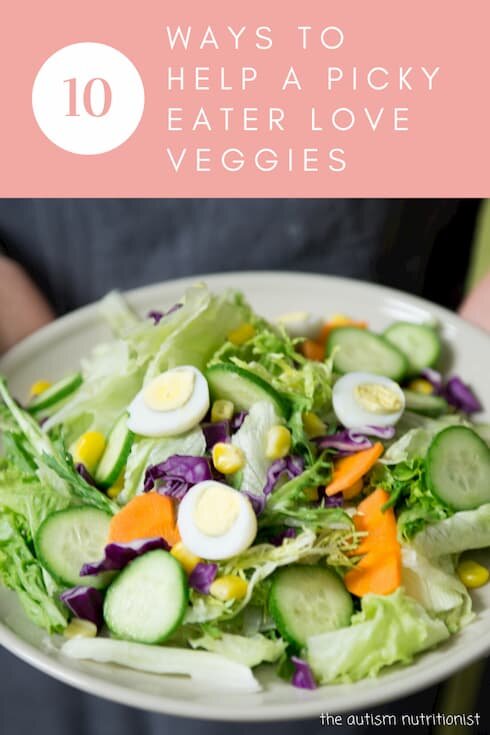This article shares 10 ways to help your picky eater learn to eat vegetables…without a battle.

How can you get your child to eat vegetables more often and more willingly?
It’s at the top of the wish list for pretty much every parent I work with.
If veggies are so good for us, why do our kids dislike them so much?
It’s not just to make our lives harder! There are real reasons that your child dislikes vegetables.
Why Kids Don’t Like to Eat Vegetables
You might know from your own experience that vegetables can be an acquired taste. Unlike fruits, they’re not sweet. And this is a big turnoff for young palates. Kids are wired to dislike bitter-tasting foods, and most vegetables, unfortunately, are pretty bitter.
Additionally, many picky eaters prefer foods with predictable and homogenous textures. Because they’re not manufactured in a factory, vegetables come with all sorts of inconsistencies and surprises when it comes to their textures. Even baby-cut carrots (which actually do come from a factory) are completely unpredictable when it comes to their texture and visual appearance.
These barriers are what could be standing between your picky eater and veggies currently, but they don’t mean that your picky eater can never learn to like vegetables.
Try these easy tips to help your child learn to love vegetables.
10 Ways to Help a Picky Eater Eat Vegetables
Consider Texture
Most picky eaters are particular about texture. Identify your child’s preferred food texture and try to match that. Many foods change texture when they’re cooked, so consider how you prepare the vegetable as well.
Below you’ll see a list of vegetables by different texture. Once you know which texture your child prefers most, you can select specific veggies to try.
You can also start with freeze-dried vegetables, which are especially great for crunch-lovers.
Starchy Vegetables for Picky Eaters
-
Sweet potatoes
-
Potatoes (especially with butter, cheese, and/or salt)
-
Roasted or mashed carrots
-
Peas
Crunchy Vegetables for Picky Eaters
-
Sugar snap peas
-
Jicama
-
Carrots
-
Kohlrabi
-
Bell pepper
-
Raw string beans
Match their Favorite Flavors
New food introductions are most successful when they’re not random. Your child will be more likely to eat a vegetable that tastes familiar, so focus on matching their taste preferences. You can do this by adding a dip, seasoning, or sauce. Cooking can also change the taste. For example, roasting usually makes vegetables taste sweeter.
If your child likes sweet foods, consider the following vegetables:
-
Roasted carrots, sweet potatoes, and butternut squash (you can add maple syrup or a dash of sugar to these, too)
-
Cooked peas
-
Corn
-
Beets
-
Rutabaga
Pair with a Dip
Dips are great not only because they’re fun, but also because they can mask the flavor and texture of whatever is being dipped into them. When introducing a new vegetable, provide a preferred dip.
Get Creative with Cooking
The way that vegetables are prepared is so important. Cooking changes the taste and texture. We never know what a fussy eater will like, so it’s important to get creative and try a bunch of different preparations.
Don’t just offer something one way once and assume that your child’s reaction is finite. Try again and try a different way. The more you try the more opportunities your child has to learn to like it.
Try all of these ways to prepare vegetables:
-
Roasted
-
Pureed
-
Crinkle cut
-
Breaded
-
In bites, coins, or strips
-
Grated
-
Soup
-
As fritters
-
Raw
-
Steamed
-
Sautéed
-
With cheese
-
In noodles
Start in the Kitchen
If you want your child to eat vegetables, get them involved in cooking vegetables. Kids who cook are more likely to eat.
Your child hates the kitchen? I’ve got 5 ways to get your child excited about cooking.
You find cooking with your child torturous? Here are 5 ways to cook with your picky eater without losing your mind.
Plant a Vegetable Seed (really!)
Countless studies show that kids who garden are more likely to eat fruits and vegetables. The benefits extend into adulthood – kids who garden grow into college students who eat more vegetables than their peers. You don’t need a ton of space or time to start growing vegetables. Herbs, lettuces, and radishes grow well in containers. Be sure to include your child in selecting and planting the seeds.
Encourage Play
The more your child can engage with vegetables using their senses, the more likely they will be to eat vegetables. Encourage play at the table or outside of mealtimes. Build mashed potato volcanoes, create a game of tic tac toe, or just get silly.
Ask for Input
Kids are more inclined to eat when they are part of the decision making process. Include your child in grocery shopping or making the dinner menu. Ask how they’d like something prepared. Their input can increase their willingness to eat.
Pair with Preferred Foods
Studies show that kids are more likely to eat new and non-preferred foods when they’re paired with ones that they like. Serve veggies alongside preferred foods or prepare them together. Add cheese, sauce, or a favorite roll. Don’t worry if it’s not a natural pairing. Your child’s liking it is all that matters.
Serve Vegetables When They’re Hungry
Hungry kids are more likely to eat. So, instead of only serving vegetables alongside preferred foods at mealtimes, pack them in your child’s lunchbox, serve them for snack, or offer them before dinner when they’re hungry before the meal is ready. Remember, if you want your child to eat vegetables, you need to serve vegetables.



0 Comments